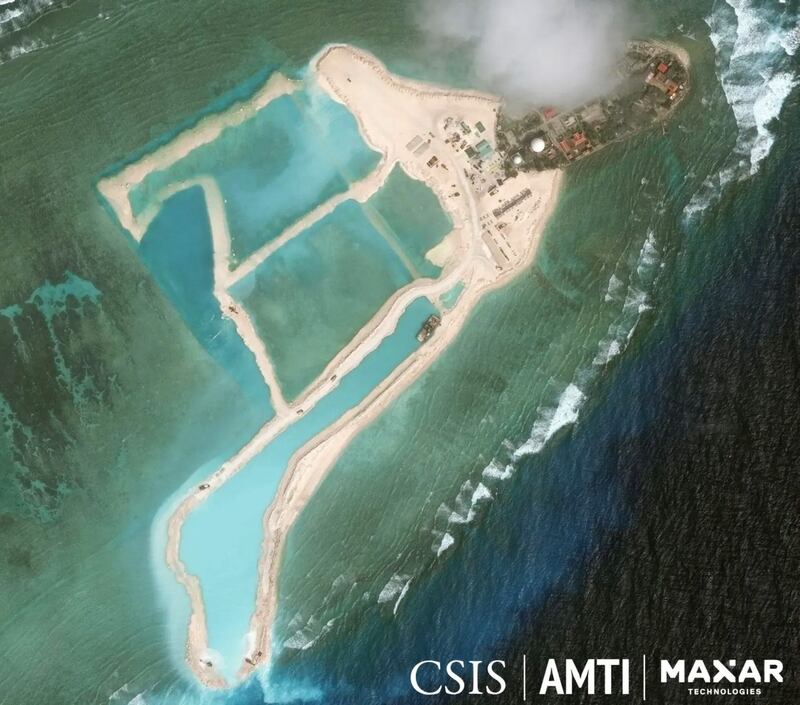UPDATED AT 9:19 p.m. ET ON 12-15-2022
Vietnam has accelerated its island building in the South China Sea where China has fully militarized three of its artificial islands, with Hanoi reclaiming about 80% of new land in the last year, a new study found.
The report " Vietnam's major Spratly expansion", released by the Asia Maritime Transparency Initiative (AMTI) at the Washington-based Center for Strategic and International Studies, said however that Vietnam's total reclamation area to date is still less than 20% of China's.
“Vietnam has created 520 acres [210 hectares] of new land in the Spratlys in the last ten years while China built 3,200 acres [1,295 hectares],” Greg Poling, AMTI’s director, told RFA.
Six parties – Brunei, China, Malaysia, the Philippines, Taiwan and Vietnam – hold conflicting claims over the South China Sea and the islands in the sea but China’s claims are by far the most expansive.
Only China, the Philippines and Vietnam are known to have been reclaiming land for further construction on their occupied islands and reefs. Beijing is believed to have finished the construction and militarization of three of its artificial islands – Subi, Fiery Cross and Mischief Reef – all within the Spratly archipelago.
China has also fully developed Woody Island in the Paracel archipelago and uses it as the military and administrative capital for all of its claims in the South China Sea.
Vietnam and Taiwan also claim sovereignty over some islands in the Paracels but China occupies all of them.
‘Defensive reclamation’
AMTI’s report said Vietnam has expanded dredging and landfill work at several of its outposts in the Spratly Islands, creating roughly 420 acres (170 hectares) of new land in 2022 alone and bringing its total in the last ten years to 540 acres (219 hectares).
Namyit Island, Pearson Reef, Sand Cay, and Tennent Reef, which are called respectively Nam Yet, Phan Vinh, Son Ca and Tien Nu in Vietnamese, are identified as the most significantly developed outposts.
The expansion allows the outposts to host larger vessels, including military ships, the report said.
It said that new dredging and landfill work has also begun at another five features in the Spratlys which up to now only host small rigs and platforms.
Vietnam has 49 or 51 outposts spread across 27 features, AMTI said, adding that there is evidence of reclamation at ten of the features.
The development process “involves the use of clamshell dredgers and construction equipment to scoop up sections of shallow reef and deposit the sediment on the area targeted for landfill,” according to the report.
“This is a more time consuming and less arbitrarily destructive process than the cutter suction dredging that China used to build its artificial islands,” it said.
AMTI’s Poling said that in his opinion, Vietnam's methods are “considerably less damaging to the wider environment, though of course destroying 520 acres of coral reef is still quite bad for the environment and fisheries.”
“I wouldn't describe this as nearly as destabilizing as what China did as what matters most is what they're used for,” said the analyst, adding that “China uses its islands to harass and coerce Southeast Asian countries.”
“If Vietnam's buildup remains defensive, then it really isn't the same,” he said.
For its part, Beijing accused Hanoi of reinforcing “illegally-held features” by land reclamation and military deployment, as well as “setting up defenses and operating on these islands and reefs.”
A Chinese think-tank, the South China Sea Probing Initiative, said in a report that as Vietnam tries" to trumpet that the islands and reefs of the Spratly Islands held by it are for civilian uses, they actually have a strong military dimension."
“As the Vietnamese troops and civilians have become increasingly active in the Vietnamese-held islands and reefs as well as the surrounding waters, the risk of any friction and conflict couldn’t be belittled,” the report said.

PCA opens in Hanoi
Vietnam and China, haven’t responded to the new findings in the report but previously, Vietnamese official channels insisted that Hanoi adhere strictly to the Declaration of the Conduct of Parties in the South China Sea, as well as agreements with China and other regional countries.
Hanoi also repeatedly claimed its “indisputable sovereignty” over islands and reefs in the South China Sea, as well as challenging Beijing’s maritime claims.
In July 2016, a U.N. arbitral tribunal ruled against China’s historic rights claims within its so-called “nine-dash line” that encircles almost 90% of the South China Sea.
The tribunal at the Permanent Court of Arbitration (PCA) in The Hague issued this arbitral award in response to a legal challenge brought against China in 2013 by the Philippines. China refused to participate in the arbitration, rejected the PCA’s ruling, and has continued to defend its claims.
In the latest development, the PCA has just formally opened an office in Hanoi, its second office in Asia after Singapore and the fifth outside of its headquarters in The Hague, according to a Dec. 1 press release.
Vietnam has said it did not rule out a possibility of bringing Beijing before an international tribunal similar to the Philippines’ 2013 lawsuit.
This story has been updated to correct the date in the 8th paragraph.
